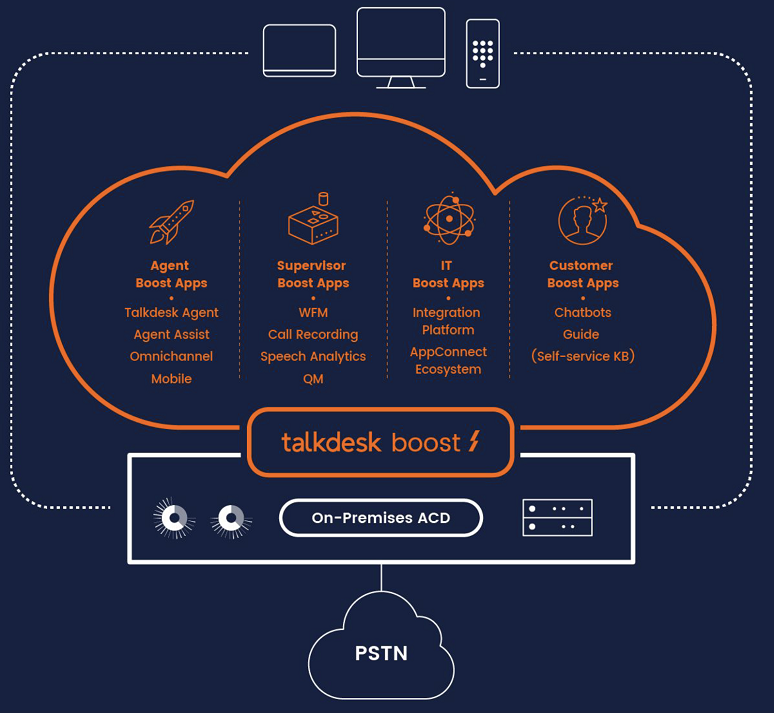Whenever I discuss the topic of digital transformation with IT or business leaders, I advise them to take a chip shot rather than a moon shot.
What I mean by that is most people have a vision of their digital strategy’s endgame, but knowing how to get from here to there can seem daunting. Take digital healthcare as an example. We can envision a day when everything is digitized, people and assets are continuously monitored, and predictive AI keeps us ahead of problems. Trying to build a plan for that moon shot is difficult, if not impossible. But taking a chip shot by deploying video in doctors’ offices to make remote consultations easier is doable – and that’s a simple initiative that can have big results.
In contact centers, the cloud provides a path to modernization, omnichannel support, and the use of AI, but the majority of cloud adoption has been with small to midsize organizations. This begs the question: If the cloud provides so much value, why haven’t large contact centers migrated?
When I ask contact center managers or IT leaders this question, I get a myriad of answers, but the majority revolve around wanting to sweat the assets a bit longer, uncertainty about using the cloud, or not wanting to lay out the budget to do the transition. While these decision makers view the shift to the cloud as risky, a business leader or the person in charge of customer experience think of the opposite as risky. In not moving the contact center to the cloud, a company misses out on a number of critical features that enhance customer interactions, and this creates a conundrum for businesses.
With an offering introduced today, cloud contact center provider Talkdesk is providing organizations a way to take a chip-shot approach to the cloud, particularly with their ACDs. Sometimes the “if it ain’t broke, don’t fix it” approach seems prudent as it minimizes business risk. However, if hockey legend
Wayne Gretzky is right and you always want to skate to where the puck is going to be, you can’t get there with on-premises ACDs because they can’t deliver critical features such as AI-based intelligence, support for mobile workers, digital channels, and cloud-based agility.
Talkdesk’s new offering,
Boost, is a hybrid architecture meant to enable businesses to modernize their contact centers by layering a number of AI-driven contact center applications on top of a legacy ACD. These new apps will “boost” agent productivity, operational efficiency, agility, and customer experience without forcing a rip and replace. Boost comprises:
- Agent Boost
- Talkdesk agent -- Unified desktop, softphone, screen pop, context
- Mobile version of agent desktop
- Agent assist -- AI-based agent that pushes answers to agents
- Omnichannel -- More than 27 channels, including chat and SMS
- IT Boost
- Pre-built integrations into CRM and other business tools
- AppConnect integration to more than 50 apps in Talkdesk’s innovation ecosystem
- Supervisor Boost
- Cloud-native workforce management
- Speech analytics of real-time and historical calls
- Quality monitoring -- Rep training to improve performance and increase satisfaction
- Reporting and analytics -- Real-time dashboards, benchmarking, and historical analytics
- Customer Boost
- Chatbot builder for customer self-service
- Talkdesk guide -- Self-service knowledge base for call deflection
Looking under the covers, Boost leverages Talkdesk’s xConnect feature, which uses a SIP trunk to connect the ACD to its cloud service. PSTN calls coming into the ACD are routed to the Talkdesk cloud via a secure IP connection. Each call received from the ACD is connected to the Talkdesk agent.
All the ACD routing intelligence and logic remains the same, so implementing Boost should create no deployment friction. This is an important to note, because routing logic is typically expensive and time consuming to build, so few companies will want to scrap what they have and start over in the cloud. Because xConnect is just a redirect of the call, it can work with any ACD, including from Avaya, Cisco, and Genesys.
This hybrid approach could be a real boon to Talkdesk for its upmarket moves. The carrot for most businesses will be the modernized agent desktop, as that’s where the most pain is likely being felt with respect to customer experience. The low-disruption implementation removes deployment risk, which should help Talkdesk get its foot in the door of companies that might not have previously considered the company. Once it’s established a relationship, it should be able employ a “land and expand’ sales motion to expand its footprint, possibly kicking the incumbent out.
Pricing is in line with Talkdesk’s current model, less the calling, obviously, since that’s handled by the on-premises system. Businesses that adopt Boost can expect to pay somewhere in the neighborhood of $60 to $120 per user per month based on features selected.
Boost gives large, risk-adverse enterprises the best of both worlds: a modernized contact center that delivers agility and greater efficiencies, which lead to CX improvements, while enabling the business to keep current assets in place until its ready to end of life a system.











